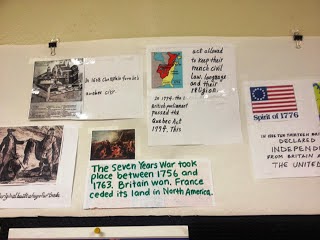One of the most interesting illustrations on the timeline, which a student found and printed on computer lab day, shows the Norse explorers meeting and trading with the native Beothuk.
If you ever get a group of students as knowledge-hungry as my seniors and want to share with them the wonders of the internationally renown historic site L'Anse aux Meadows in Newfoundland, I highly recommend this 29-minute documentary entitled The Vinland Mystery.
- Provided students with the exact time markers at which they should start listening for the answer to each question.
- Made the answers multiple choice.
- Supplied illustrations with some of the multiple choice options.
FAVOURITE TECHNIQUE ALERT!
Another activity students seemed to really enjoy was the "two article technique," which I employed using two of the three articles on Vikings free for download from Bogglesworld.
How:
Divide the class into two groups, A and B. Each group is given a different graded article on the same topic and 10-15 minutes in which to digest it. Each A student is then paired with a B; they teach each other the content of their respective articles (paraphrasing, no paper). Warn students that they will be tested on the peer taught material and remind them that communication is the shared responsibility of speaker and listener. Don't forget to supply them with any needed language to accomplish this, such as, "Did you say....?" "How do you spell that?" "Can you explain that in different words?" If you're worried that one student might get shorted by being paired with a classmate who isn't able to teach the material very well, you could set up queues facing each other whereby the As are stationary and, after 3-5 minutes, the Bs move one seat to their right. Depending on how much time you have, you can thus allow each student to be taught the same article a few times--each time by a different peer. Or you could set it up in teaching teams. Oh, my...the possibilities are endless, aren't they?
If you like any of these ideas or end up using anything here, I would love to hear about it.









No comments:
Post a Comment
Thank you for participating in this forum. Anonymous commenting is available, but is not intended to shield those taking pot shots at those of us challenging PBLA. If you are here to do that, please use your name.